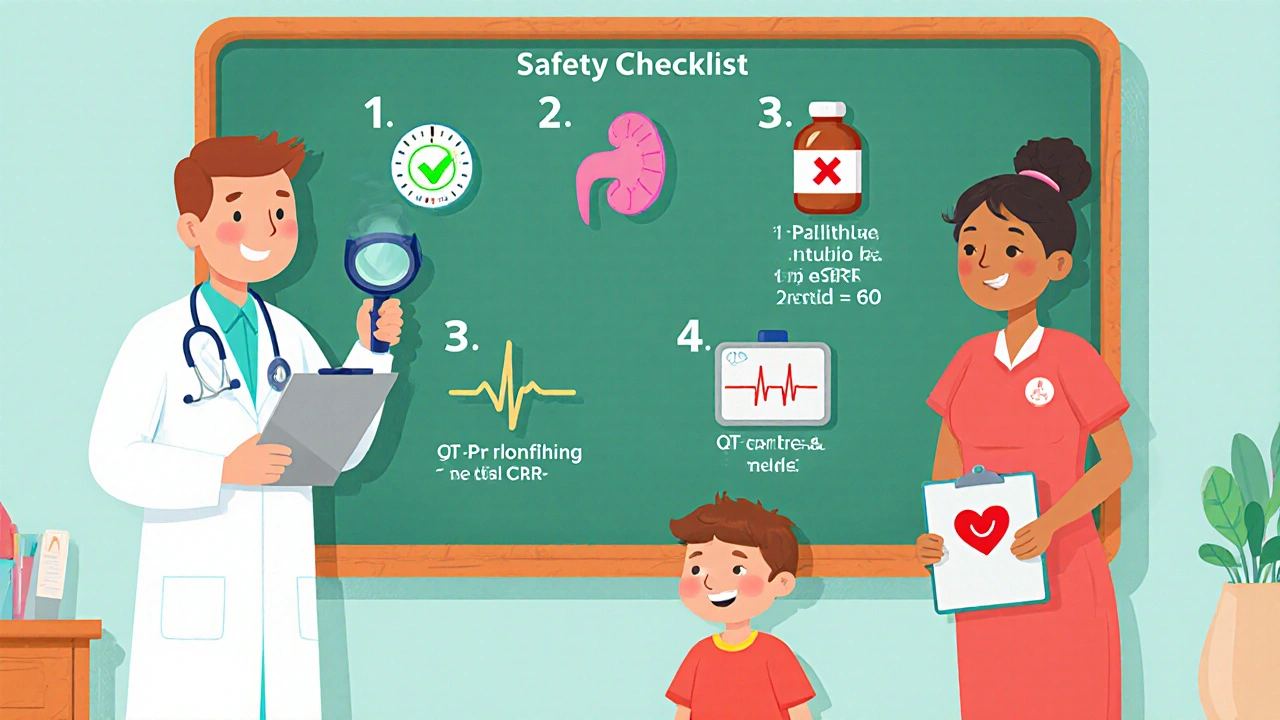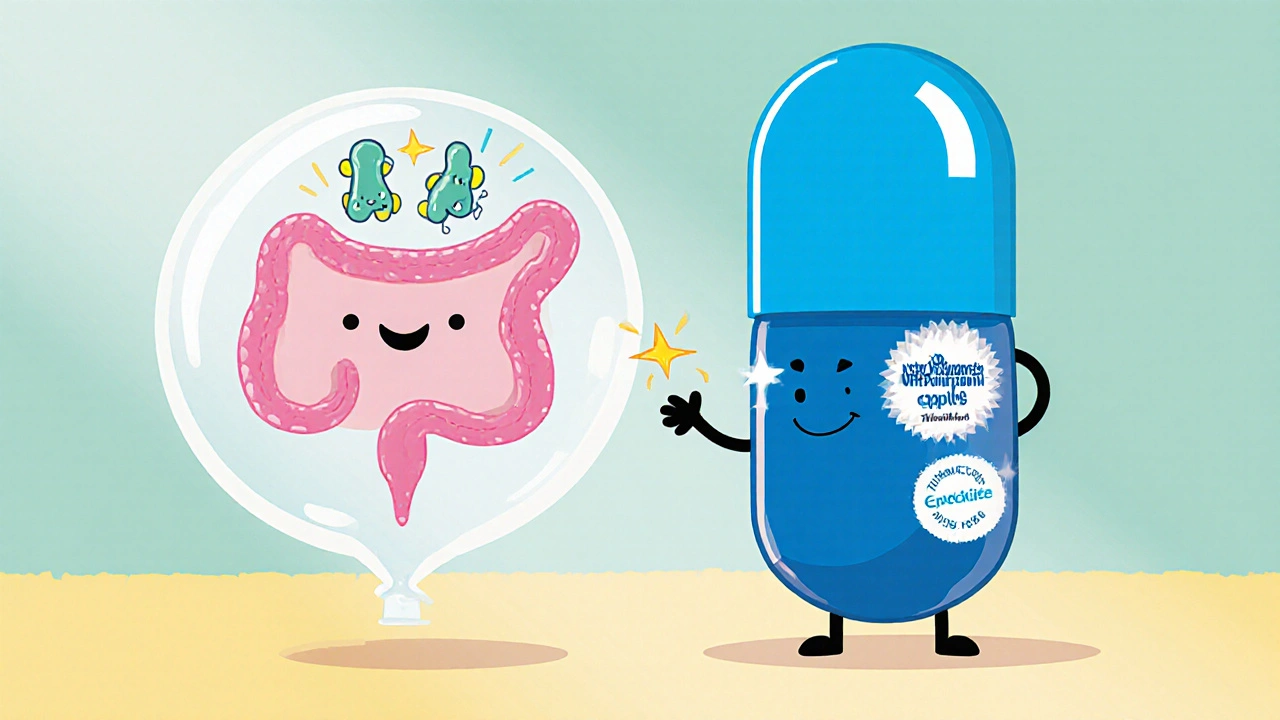Nitrofurantoin Cardiac Risk Assessment Tool
Enter your patient's information below to assess potential cardiac risk when using Nitrofurantoin for UTIs. This tool helps identify patients who may need additional monitoring or alternative therapy.
When treating uncomplicated urinary tract infections, Nitrofurantoin is a synthetic nitrofuran antibiotic that concentrates in urine and targets common bacteria such as E. coli. First approved in the 1950s, it remains a first‑line choice in many guidelines.
Why Nitrofurantoin Is Popular for UTIs
Its high urinary concentration means the drug works where the infection lives while keeping systemic exposure low. That profile reduces gut flora disruption compared with broader‑spectrum agents, which is why clinicians often reach for it after a positive dipstick.
How Nitrofurantoin Works
The molecule interferes with bacterial enzymes that process carbohydrate metabolism, leading to bacterial death. Because the drug needs to be reduced by bacterial nitroreductases, it is especially effective against Gram‑negative organisms that thrive in the bladder.
Cardiovascular Concerns: What the Data Show
Most patients tolerate the medication without trouble, but a subset experiences cardiac effects that merit attention. The most frequently discussed issue is QT‑interval prolongation, a subtle change on an electrocardiogram (ECG) that can set the stage for torsades de pointes, a potentially lethal arrhythmia.
QT Interval refers to the time between the start of the Q wave and the end of the T wave on an ECG, reflecting the heart’s electrical repolarisation phase. A drug that slows this repolarisation can lengthen the interval. Clinical case reports from the early 2000s linked high‑dose nitrofurantoin (especially in patients with renal impairment) to measurable QT‑prolongation.
Who Is Most at Risk?
Three patient groups deserve extra vigilance:
- Renal dysfunction: Nitrofurantoin is eliminated by the kidneys. When clearance drops, systemic levels rise, increasing the chance of off‑target cardiac effects.
- Concurrent QT‑prolonging drugs: Medications like macrolide antibiotics, certain antihistamines, and some anti‑arrhythmics share the same electrophysiological pathway.
- Pre‑existing cardiac disease: Patients with known long QT syndrome, heart failure, or recent myocardial infarction have a lower safety margin.
Drug Interactions that Amplify Cardiac Risk
Drug Interactions occur when two medicines affect each other’s metabolism, distribution, or elimination, potentially leading to adverse events. Nitrofurantoin is metabolised partly by hepatic enzymes and excreted unchanged in urine. When combined with drugs that inhibit renal tubular secretion (e.g., probenecid) or that compete for the same plasma‑protein binding sites, its plasma concentration can climb.
Particularly worrisome are interactions with:
- Warfarin: Both drugs bind to albumin; competitive displacement may increase warfarin’s anticoagulant effect, indirectly stressing the cardiovascular system.
- Beta‑blockers: While not directly affecting the QT interval, they can mask early signs of tachyarrhythmias, complicating monitoring.
- Fluoroquinolones: Another class known for QT prolongation; concurrent use should be avoided unless no alternatives exist.
Monitoring Strategies for Safe Use
Before starting nitrofurantoin, consider a baseline ECG for patients with any of the risk factors listed above. Follow‑up ECGs after 3-5 days of therapy can catch early interval changes.
Blood tests to assess renal function (eGFR) are essential. The drug is generally contraindicated when eGFR falls below 60 mL/min/1.73 m² for standard dosing, and below 30 mL/min/1.73 m² for any use.
If an ECG shows QTc > 450 ms in men or > 470 ms in women, weigh the benefits against the risk. Switching to a nitro‑type‑free antibiotic such as trimethoprim‑sulfamethoxazole (if not contraindicated) is often safer.
Clinical Evidence and Guideline Recommendations
Large meta‑analyses published in 2022 and 2024 examined over 12,000 nitrofurantoin users. The pooled incidence of serious cardiac events was 0.03 %, a figure comparable to placebo in low‑risk groups. However, subgroup analysis highlighted a 4‑fold increase in those with eGFR < 40 mL/min/1.73 m².
The American College of Physicians (ACP) 2023 guideline states: “For patients with normal renal function and no concurrent QT‑prolonging medication, nitrofurantoin remains a first‑line option for uncomplicated cystitis.” The European Association of Urology (EAU) adds a precaution: “Avoid nitrofurantoin in patients with known prolonged QT or on class III anti‑arrhythmics.”

Practical Takeaway: When to Use Nitrofurantoin Safely
Summarise the decision process in three steps:
- Check renal function. If eGFR ≥ 60, proceed; if lower, consider dosage adjustment or alternative.
- Review medication list for QT‑prolonging agents. Pause or replace overlapping drugs if possible.
- Assess cardiac history. In patients with prior arrhythmias, obtain a baseline ECG and monitor closely.
If all three boxes are clear, the benefits of nitrofurantoin for a quick, focused UTI treatment usually outweigh the cardiac risk.
Frequently Asked Questions
Can nitrofurantoin cause heart attacks?
No direct link between nitrofurantoin and myocardial infarction has been confirmed. Reported cardiac events focus on rhythm disturbances, not coronary artery blockage.
How long should I take nitrofurantoin?
For uncomplicated cystitis, a 5‑day course is standard. Longer courses increase exposure without added efficacy.
Is it safe to take nitrofurantoin while on a beta‑blocker?
Generally yes, but monitor heart rate because beta‑blockers can mask early tachycardia. Discuss any concerns with your prescriber.
What symptoms suggest a cardiac side effect?
Feelings of light‑headedness, palpitations, or fainting spells during therapy warrant immediate medical review and possibly an ECG.
Should I stop the medication if I develop mild dizziness?
Mild dizziness alone isn’t a definitive sign of QT‑prolongation, but it should trigger a clinician‑led assessment. Do not stop abruptly without advice.
Bottom Line
For most healthy adults, nitrofurantoin remains a safe, effective first‑line treatment for uncomplicated urinary tract infections. The key to protecting heart health lies in proper patient selection, renal‑function checks, and awareness of drug‑interaction pitfalls. By following a simple risk‑assessment checklist, you can minimize the chance of cardiac complications while reaping the antibiotic’s benefits.


It is not a coincidence that the pharmaceutical industry pushes nitrofurantoin while ignoring the hidden cardiac hazards that are quietly documented in obscure papers that never see mainstream journals. The same way mainstream media hides the truth about the government colluding with drug manufacturers to suppress data that could expose a larger pattern of cardiovascular risk. This risk is being deliberately downplayed to protect profits. The public is left to trust the official guidelines without questioning the underlying motives.
The narrative presented feels polished but underneath lies a subtle tremor of imbalance. The very act of dismissing cardiac warnings as rare events feels like turning a blind eye to patients who could be silently slipping into arrhythmia while the author celebrates nitrofurantoin like a hero of modern medicine.
i think the drug is safe but who knows
From a philosophical standpoint one might view the prescription of nitrofurantoin as a micro‑cosm of risk versus reward. The decision hinges on the balance between alleviating infection and exposing the heart to potential electrical disturbances. The clinician, like a moral arbiter, must weigh the evidence with measured detachment.
While the article enumerates standard precautions, it neglects to highlight the deeper pharmacokinetic subtleties that only a seasoned pharmacologist would appreciate; the omission betrays a superficial engagement with the literature.
Hey there! u r right that nitrofurantoin can be tricky but most peeps do fine if they keep an eye on their kidneys and meds 🙌 just remember to chat with ur doc if u feel weird
It would be remiss not to consider the broader context wherein regulatory agencies are incentivized to endorse agents such as nitrofurantoin despite emerging evidence of electrophysiologic perturbations. The subtle alignment of commercial interests with clinical guidelines demands rigorous independent scrutiny to safeguard patient autonomy.
Let us embrace a comprehensive approach that situates nitrofurantoin within a holistic patient assessment; beginning with an evaluation of renal clearance, followed by a meticulous review of concurrent QT‑prolonging medications, and culminating in a pre‑therapy electrocardiographic baseline ensures that we are not merely treating a bacterium but protecting the cardiac integrity of the individual. Moreover, educating patients about the signs of arrhythmia-such as dizziness, palpitations, or syncope-empowers them to act promptly. Should an abnormal QTc emerge, transitioning to an alternative antimicrobial such as trimethoprim‑sulfamethoxazole, when appropriate, reflects our commitment to personalized medicine and risk mitigation.
Great summary! 📋 In practice, I always order a quick eGFR check before prescribing nitrofurantoin and set a reminder for a follow‑up ECG around day four; this simple protocol catches most QT changes early and keeps patients safe.
The exposition, while thorough, suffers from an overreliance on statistical aggregates that obscure the clinical relevance of rare cardiac events; a more nuanced discussion of patient‑specific factors would better serve clinicians seeking actionable guidance.
Check kidneys first, avoid QT drugs, monitor ECG if needed.
Indeed, the triad of renal function, medication interaction, and electrophysiologic monitoring forms a logical lattice through which prudent prescribing can navigate the uncertainties inherent in therapeutic decision‑making.
The stakes are high; ignoring the QT dilemma is nothing short of reckless theater.
In conclusion, integrating pharmacovigilance parameters-namely glomerular filtration rate assessment, concomitant QT‑interval modulating agent review, and serial electrocardiographic surveillance-optimizes the therapeutic index of nitrofurantoin while preserving cardiovascular homeostasis; such evidence‑based stewardship epitomizes best practice in antimicrobial stewardship programs.